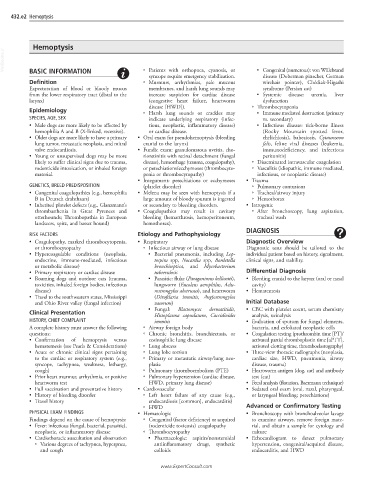Page 892 - Cote clinical veterinary advisor dogs and cats 4th
P. 892
432.e2 Hemoptysis
Hemoptysis
VetBooks.ir
○ Patients with orthopnea, cyanosis, or
BASIC INFORMATION
syncope require emergency stabilization. ■ Congenital (numerous): von Willebrand
disease (Doberman pinscher, German
Definition ○ Murmurs, arrhythmias, pale mucous wirehair pointer), Chédiak-Higashi
Expectoration of blood or bloody mucus membranes, and harsh lung sounds may syndrome (Persian cat)
from the lower respiratory tract (distal to the increase suspicion for cardiac disease ■ Systemic disease: uremia, liver
larynx) (congestive heart failure, heartworm dysfunction
disease [HWD]). ○ Thrombocytopenia
Epidemiology ○ Harsh lung sounds or crackles may ■ Immune mediated destruction (primary
SPECIES, AGE, SEX indicate underlying respiratory (infec- vs. secondary)
• Male dogs are more likely to be affected by tious, neoplastic, inflammatory disease) ■ Infectious disease: tick-borne illness
hemophilia A and B (X-linked, recessive). or cardiac disease. (Rocky Mountain spotted fever,
• Older dogs are more likely to have a primary • Oral exam for pseudohemoptysis (bleeding ehrlichiosis), babesiosis, Cytauxzoon
lung tumor, metastatic neoplasia, and mitral cranial to the larynx) felis, feline viral diseases (leukemia,
valve endocardiosis. • Fundic exam: granulomatous uveitis, cho- immunodeficiency, and infectious
• Young or unsupervised dogs may be more rioretinitis with retinal detachment (fungal peritonitis)
likely to suffer clinical signs due to trauma, disease), hemorrhage (trauma, coagulopathy), ○ Disseminated intravascular coagulation
rodenticide intoxication, or inhaled foreign or petechiations/ecchymoses (thrombocyto- ○ Vasculitis (idiopathic, immune mediated,
material. penia or thrombocytopathy) infectious, or neoplastic disease)
• Integument: petechiations or ecchymoses • Trauma
GENETICS, BREED PREDISPOSITION (platelet disorder) ○ Pulmonary contusions
• Congenital coagulopathies (e.g., hemophilia • Melena may be seen with hemoptysis if a ○ Tracheal/airway injury
B in Deutsch drahthaars) large amount of bloody sputum is ingested ○ Hemothorax
• Inherited platelet defects (e.g., Glanzmann’s or secondary to bleeding disorders. • Iatrogenic
thrombasthenia in Great Pyrenees and • Coagulopathies may result in cavitary ○ After bronchoscopy, lung aspiration,
otterhounds; Thrombopathia in European bleeding (hemarthrosis, hemoperitoneum, tracheal wash
landseers, spitz, and basset hound) hemothorax).
DIAGNOSIS
RISK FACTORS Etiology and Pathophysiology
• Coagulopathy, marked thrombocytopenia, • Respiratory Diagnostic Overview
or thrombocytopathy ○ Infectious airway or lung disease Diagnostic tests should be tailored to the
• Hypercoagulable conditions (neoplasia, ■ Bacterial pneumonia, including Lep- individual patient based on history, signalment,
endocrine, immune-mediated, infectious tospira spp, Nocardia spp, Bordetella clinical signs, and stability.
or metabolic disease) bronchiseptica, and Mycobacterium
• Primary respiratory or cardiac disease tuberculosis Differential Diagnosis
• Roaming dogs and outdoor cats (trauma, ■ Parasitic: fluke (Paragonimus kellicotti), • Bleeding cranial to the larynx (oral or nasal
toxicities, inhaled foreign bodies, infectious lungworm (Eucoleus aerophilus, Aelu- cavity)
disease) rostrongylus abstrusus), and heartworm • Hematemesis
• Travel to the southwestern states, Mississippi (Dirofilaria immitis, Angiostrongylus
and Ohio River valley (fungal infection) vasorum) Initial Database
Clinical Presentation ■ Fungal: Blastomyces dermatitidis, • CBC with platelet count, serum chemistry
Histoplasma capsulatum, Coccidioides
analysis, urinalysis
HISTORY, CHIEF COMPLAINT immitis • Evaluation of sputum for fungal elements,
A complete history must answer the following ○ Airway foreign body bacteria, and exfoliated neoplastic cells
questions: ○ Chronic bronchitis, bronchiectasis, or • Coagulation testing (prothrombin time [PT]/
• Confirmation of hemoptysis versus eosinophilic lung disease activated partial thromboplastin time [aPTT],
hematemesis (see Pearls & Considerations) ○ Lung abscess activated clotting time, thromboelastography)
• Acute or chronic clinical signs pertaining ○ Lung lobe torsion • Three-view thoracic radiographs (neoplasia,
to the cardiac or respiratory system (e.g., ○ Primary or metastatic airway/lung neo- cardiac size, HWD, pneumonia, airway
syncope, tachypnea, weakness, lethargy, plasia disease, trauma)
cough) ○ Pulmonary thromboembolism (PTE) • Heartworm antigen (dog, cat) and antibody
• Prior heart murmur, arrhythmia, or positive ○ Pulmonary hypertension (cardiac disease, test (cat)
heartworm test HWD, primary lung disease) • Fecal analysis (flotation, Baermann technique)
• Full vaccination and preventative history • Cardiovascular • Sedated oral exam (oral, nasal, pharyngeal,
• History of bleeding disorder ○ Left heart failure of any cause (e.g., or laryngeal bleeding; petechiations)
• Travel history endocardiosis [common], endocarditis)
○ HWD Advanced or Confirmatory Testing
PHYSICAL EXAM FINDINGS • Hematologic • Bronchoscopy with bronchoalveolar lavage
Findings depend on the cause of hemoptysis: ○ Congenital (factor deficiency) or acquired to examine airways, remove foreign mate-
• Fever: infectious (fungal, bacterial, parasitic), (rodenticide toxicosis) coagulopathy rial, and obtain a sample for cytology and
neoplastic, or inflammatory disease ○ Thrombocytopathy culture
• Cardiothoracic auscultation and observation ■ Pharmacologic: aspirin/nonsteroidal • Echocardiogram to detect pulmonary
○ Various degrees of tachypnea, hyperpnea, antiinflammatory drugs, synthetic hypertension, congenital/acquired disease,
and cough colloids endocarditis, and HWD
www.ExpertConsult.com

